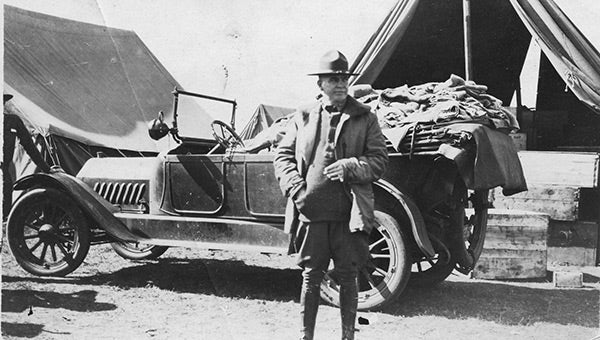100 years ago today, Alabama troops deployed to Mexican border
Published 12:54 am Saturday, October 22, 2016
By NIMROD T. FRAZIER
It was crisp, clean, invigorating weather in Montgomery. A chill was in the air on Oct. 22, 1916.
Six trains of wooden railroad cars pulled by steam engines waited in the cavernous and smoke filled train shed at the Union Station. There was a big crowd of spectators to wave goodbye to 3,194 departing officers and men of 1st, 2nd, and 4th Alabama Infantry and 1st Alabama Cavalry regiments of the National Guard.
They were mostly from 27 small towns across the state. On May 18, 1916, the National Guard as it existed was ordered to encamp at Vandiver Park north of Montgomery. Five hundred and ninety-four more were recruited after the Guard was federalized in June of 1916. This surge was due to a War Department request to recruit the Alabama National Guard to “maximum strength.”
Recruiters covered every section of the state but many of the new men simply showed up at the camp gate in Montgomery and there were rejections of 25 to 30 percent due to hookworm, venereal disease, bad teeth, tuberculosis and heart disease. Few of the recruits knew anything about a chain of command, had worked for anyone other than family, had been exposed to orders with the force of law or had been yelled at by strangers. Many had money in their pockets for the first time and were in a city where brothels and whiskey were available.
Basic Training in Montgomery was conducted by National Guard officers and non-commissioned officers, who had themselves been recruited as hometown boys and worked their way up through the ranks.
Having been sworn in by regular Army Captain William P. Screws in June of 1916, the Alabama Guard was ordered in October to join a U.S. force of regular Army troops along the border with Mexico. All of these guardsmen were volunteers and proud to be involved. There were ways to get out being called up if they wanted to do that, but few took the opportunity. Being in the Guard was “the thing to do,” especially now that they were bound for Nogales, Arizona.
A civil war had been raging in Mexico since 1910. The United States at first considered the conflict an internal Mexican affair but worried about a spill-over along its 2,000 miles of common border. When Pancho Villa, one of the guerilla leaders, raided a garrison of 240 American soldiers in Columbus, New Mexico, killing 18 and laying claims to U.S. land earlier taken from Mexico, President Wilson ordered 15,000 regular Army soldiers and ultimately over 100,000 National Guardsmen to be sent to the border. Under the command of Brigadier General John J. Pershing, the American Punitive Expedition to Mexico, as it was named, started on March 14, 1916 and would last until February 7, 1917. It was ultimately to involve a raiding force of about 6,600 regular Army cavalry and horse artillerymen who penetrated four hundred miles in two columns inside of Mexico but did not catch Villa.
The Alabama National Guard units did not fight or even cross the border. Their duty was to receive four and a half months of training. Despite the firm United States commitment to neutrality toward the conflict raging in Europe, the Army leadership was fully conscious of the sorry state of the U.S. Army, should it be dragged into the European conflict. The American Punitive Expedition to Mexico was an ideal excuse to give its men some advanced infantry training. It mostly consisted of long hours on rifle and machine gun ranges along with close order drills and practice of the manual of arms. There were increasingly long road marches and attention to physical conditioning. When in camp, the men slept in pyramid tents designed for 12 men. A Signal Company existed, but it mostly laid telephone lines and taught Morse code with semaphore flags.
There was emphasis on personal appearance and military courtesy. Capt. Screws was a stickler for both. The older hands were familiar with his “regular Army” way of soldiering, having served in summer camps at Camp Chickmauga near Chattanooga, Tenn. under regular Army instructors. They knew how Screws was involved with everything and was called “Boom, Boom” behind his back. In Arizona, he was promoted to lieutenant colonel “elect”, reflecting the Civil War way of having officers approved by the men, a practice that was coming to a close. Most of the Alabama National Guard’s 182 pre-World War I officers held regular jobs in their hometowns. They were usually respected more for leadership ability than for their day jobs. Most needed the National Guard money but were known as people whom parents trusted with their sons.
None of these units were capable of combat. In the past they existed to perform as police when needed. There would be no combat casualties on the Mexican border but a dozen men died from flu in an epidemic that would follow them to Europe.
Few of the Alabama recruits going into the newly federalized Guard in 1916 knew much of life beyond their home towns or counties. Most were skeptical about the outside world they did not know, but some were imaginative enough to think the expanding National Guard might mean an opportunity to be part of something big. It was especially meaningful for those with no hope of coming into a family business or farm, which was most of them. It was also the first really big opportunity for adventure in their lives.
Many of the young men recruited in Alabama were fiery Southerners with little education. Their wildness caused Brigadier General Edward H. Plummer to exclaim of them on the Mexican border; “In time of war, send me all the Alabamians you can get, but in time of peace, for Lord’s sake, send them to somebody else!”
The National Guard was to lead many of these ordinary men with little education to their greatest life achievement and some to tragedy. Many were enthusiastic, full of bravado and excitement, ready to leave home and have different lives. Their military service enabled them to participate in the beginning of a complex, life-wrenching event, an adventure larger than anything they ever imagined.
For more information on WW1, visit: WW1CC.org/alabama.
Editor’s note: This is the first in a series detailing Alabama’s involvement in World War I.





